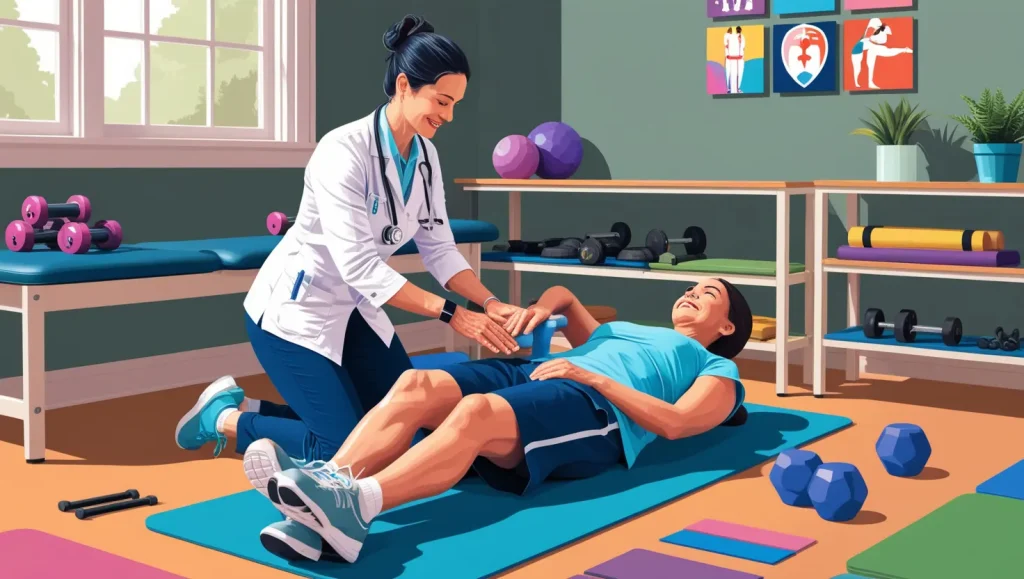Introduction
Knee pain is a prevalent issue that affects people of all ages and backgrounds. It can arise due to various factors, such as injuries, overuse, arthritis, or medical conditions. When knee pain strikes, performing everyday activities can become challenging, impacting one’s quality of life. However, turning to pain medication as a quick fix is not always the best solution. Physical therapy exercises for knee pain offer a natural, effective, and non-invasive way to alleviate discomfort and enhance knee function. In this article, we’ll explore a range of exercises specifically designed to target knee pain and improve overall knee health.
Understanding Knee Pain
Before delving into the exercises, it’s essential to understand knee pain and its root causes. Knee pain can result from injuries to the ligaments, tendons, cartilage, or bones surrounding the knee joint. Additionally, conditions like osteoarthritis, rheumatoid arthritis, and bursitis can lead to persistent knee pain. The discomfort can range from mild to severe, affecting the ability to walk, climb stairs, or participate in physical activities.
When to Seek Physical Therapy
If knee pain persists for more than a few days or significantly impacts daily activities, consulting a physical therapist is crucial. They can evaluate the underlying causes of the pain and develop personalized treatment plans. A physical therapist can identify muscle imbalances, joint issues, or poor movement patterns that contribute to knee pain.

Benefits of Physical Therapy for Knee Pain:
Physical therapy offers several advantages over traditional treatments. While pain medications provide temporary relief, physical therapy addresses the root cause of the pain. Through tailored exercise programs, physical therapists can help improve knee function, increase flexibility, and strengthen surrounding muscles. These exercises not only alleviate pain but also enhance overall knee stability and prevent future injuries.
Key Exercises for Knee Pain:
1. Quadriceps Setting
• This exercise targets the quadriceps muscles to improve knee stability.
• Sit on the floor with your legs extended and tighten the quadriceps for 5-10 seconds.
• Repeat the set multiple times throughout the day.
2. Straight Leg Raises
• Lie on your back and bend one knee while keeping the other leg straight.
• Raise the straight leg to the height of the bent knee, hold briefly, and lower it down.
• Perform 2-3 sets of 10-15 repetitions for each leg.
3. Hamstring Curls
• Stand with your feethip-width apart, holding onto a chair for balance.
• Bend one knee and bring your foot towards your buttocks.
• Slowly lower your leg and repeat for 10-15 reps on each leg.
4. Calf Raises
• Stand with your feet hip-width apart and rise onto your toes.
• Hold the position for a few seconds and lower your heels back down.
• Perform 3 sets of 15 repetitions.
Low-Impact Cardio for Knee Pain:
Cardiovascular exercise is essential for overall health, but high-impact activities can be tough on the knees. Here are some low-impact alternatives:
5. Swimming
• Swimming provides an excellent full-body workout without stressing the knees.
• Engage in swimming sessions regularly to improve cardiovascular fitness.
6. Cycling
• Cycling is gentle on the knees and helps build leg strength.
• Whether outdoors or using a stationary bike, enjoy cycling as a knee-friendly option.
Strengthening Exercises for Knee Support:
7. Step-Ups
• Stand in front of a step or platform and step up with one foot.
• Step back down and repeat with the other leg. Perform 2-3 sets of 10-15 repetitions.
8. Wall Squats
• Lean against a wall and slide down until your knees are bent at a 45-degree angle.
• Hold the position for 30 seconds to a minute, gradually increasing duration.
Balance and Proprioception Training:
9. Single-Leg Stance
• Stand on one leg for 30 seconds to improve balance and proprioception.
• Make it more challenging by closing your eyes or standing on an uneven surface.
10. Bosu Ball Exercises
• Using a Bosu ball can enhance balance and coordination while engaging the core.
• Perform exercises like squats or lunges on the Bosu ball’s rounded side.
Flexibility and Stretching:

11. Quadriceps Stretch
• Stand and bend one knee, bringing your foot towards your buttocks.
• Hold your ankle with your hand and gently stretch your quadriceps.
12. Hamstring Stretch
• Sit on the floor with one leg extended and the other bent.
• Lean forward to feel the stretch in your hamstring and hold for 30 seconds on each side.
Incorporating Resistance Bands:
13. Clamshells
• Lie on your side with your knees bent and a resistance band around your thighs.
• Open and close your knees like a clamshell, engaging your glutes.
14. Leg Presses
• Sit on a chair with a resistance band around your feet.
• Extend your legs outward against the resistance of the band.
Managing Pain and Discomfort:
15. RICE Method
• Rest, Ice, Compression, and Elevation can help manage acute knee pain.
• Rest the knee, apply ice, use a compression bandage, and elevate the leg to reduce swelling.
The Importance of Rest and Recovery:
It’s crucial to allow time for rest and recovery between exercise sessions. This allows the body to heal and adapt to the training, reducing the risk of overuse injuries.
Preventing Knee Pain in the Future:
Prevention is key to maintaining knee health in the long term. Here are some tips to prevent knee pain:
• Maintain a healthy weight to reduce stress on the knees.
• Avoid excessive high-impact activities that may strain the knee joints.
• Wear appropriate footwear to provide adequate support during physical activities.
Consulting a Professional
While these exercises can be beneficial, consulting a physical therapist is essential for personalized guidance. A physical therapist can design a comprehensive program that addresses specific needs and ensures safe progress.
Conclusion
Incorporating physical therapy exercises for knee pain into your daily routine can significantly improve knee function, reduce discomfort, and enhance overall quality of life. By focusing on targeted exercises, low-impact cardio, balance training, flexibility, and incorporating resistance bands, individuals can achieve stronger and healthier knees. Remember to listen to your body, rest when needed, and seek professional guidance for a tailored approach to your knee health.


























